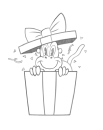Check out the premium course for additional lessons, demos, assignments and critiques!
From One-Point to Multi-Point Perspective
You've learned one-point perspective, parallel lines that recede converge at a single vanishing point. But what if two sets of lines recede in different directions? Each set has its own vanishing point. Stepping off a railroad track, you might see lines going away to the right and left, this is two-point perspective. If lines also recede up or down, that's three-point perspective.
The Three Dimensions and Orthographic Views
Every object has three dimensions:
- Width (left-right)
- Height (up-down)
- Depth (front-back)
Orthographic (ortho) views help you understand these dimensions:
- Front view: Shows width and height, you're looking straight at depth.
- Side view: Shows height and depth, you're looking straight at width.
- Top view: Shows width and depth, you're looking straight at height.
These views line up neatly:
- Front and top views align on widths.
- Front and side views align on heights.
Using Orthographic Knowledge in Perspective
Orthos provide enough information to draw objects in perspective. Artists and designers use them to:
- Establish proportions: Determine the size relationships between different parts.
- Visualize forms: Understand how objects look from different angles.
- Create turnarounds: Character designers draw orthos to animate characters from all sides.
For example, if you only have a side view of a teapot, you might not know its true shape. Combining side, front, and top views gives you a complete understanding of the form.
Preparing for Perspective Drawing
Understanding orthographic views enhances your spatial awareness. It helps you:
- Translate space to paper and paper to space.
- Make informed choices when drawing in perspective.
- Build a foundation for more complex drawings.
Remember, practice strengthens your ability to visualize and draw forms accurately. Next, we'll learn how to tilt these axes in space, moving from orthos to 3D sketches. See you in the next lesson!
Check out the premium course for additional lessons, demos, assignments and critiques!
Drawing Exercise: Creating Orthographic Views
Project: Using the object you chose for your form study (Assignment - The Secret of Simple Forms), create an ortho for it.
- Draw it from the top, side, and front views, proportioned as accurately as you can.
- Keep the object at a distance to better judge proportions.
- Plan your layout: Ensure the views line up correctly on your paper.
- Use instruments or draw freehand:
- Instruments provide precision.
- Freehand drawing enhances spatial reasoning.
This exercise develops your ability to think in three dimensions and prepares you for drawing in one, two, or three-point perspective.
Deadline - submit by April 01, 2025 for a chance to be in the critique video!








